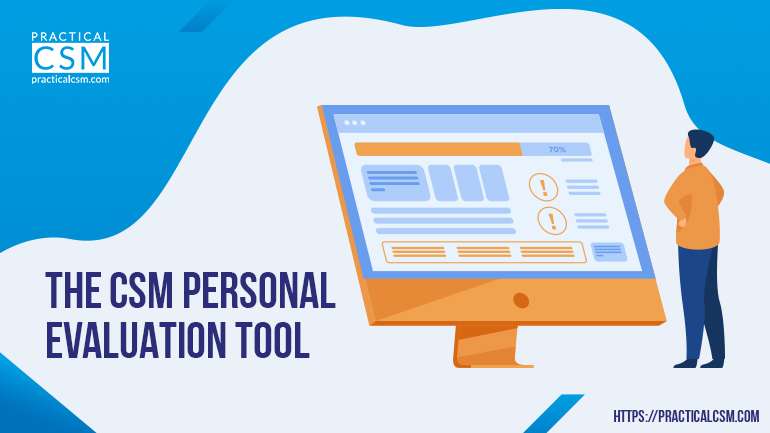The CSM Personal Evaluation Tool
Context
This article is lifted pretty much word-for-word from Module Nine of my upcoming “Certified CSM Professional” training and certification program. Module Nine covers Practical CSM Framework Phase 7: Engagement Evaluation, and the “Personal Evaluation Tool” is one of three topics covered in-depth within Video Two of Module Nine, the other two being the “Engagement Evaluation Tool” and “Using a Roadmap to Engage with Senior Decision Makers”.
As well as receiving all the training materials, students of the “Certified CSM Professional” training and certification program also gain access to over twenty such tools that help them perform their role efficiently and effectively, ranging from checklists to analysis tools to document templates.
I hope this short extract from the course is useful and interesting. If you’d like your own copy of the Personal Evaluation Tool that is discussed in this short article then email me at rick.adams@practicalcsm.com and I’ll be happy to send you it.
Using the Personal Evaluation Tool
Once the CSM has (either alone or as a team exercise with colleagues) evaluated the overall performance of the engagement, and considered the value returned for all parties – customer, supplier and CSM – and the lessons learned for future similar engagements, it makes a lot of sense for the CSM to also evaluate their own performance within this engagement, again with a view to learning lessons about what went well that can be replicated in the future and what did not go so well that perhaps indicates a skill or knowledge gap that needs to be filled in order to perform even better next time.
The Personal Evaluation Tool is designed for CSMs to do exactly this. As with the Engagement Evaluation Tool it is up to the CSM as to how often to use the tool, or indeed whether or not to use the tool at all for any specific engagement. If the CSM manages just a few, larger engagements then it might make sense to perform the personal evaluation for each one. However if they manage many tens or hundreds of customer engagements then it will probably make more sense for CSMs to perform just one personal evaluation in any one period – perhaps quarterly or half annually for example – in order to gain the value from the evaluation process, but without overburdening themselves with unnecessary repetition of work.
The Personal Evaluation Tool is very simple to use and is provided in Microsoft PowerPoint format which allows CSMs to amend and customize it very easily. The tool is based on the “Spider Chart” where you have a circle or “wheel” which is divided into a series of segments and concentric rings. Each segment relates to a specific aspect of a CSM’s performance within a customer engagement that could be evaluated. Each concentric ring represents a value from 0 to 10 that indicate the level of performance of the CSM for each aspect from low to high.

Slide 1 within the tool is a worked example to give CSMs an illustration of how the tool should look once they have evaluated their personal performance. Slides 2 onwards contain identical copies of the actual tool itself, and of course CSMs can create more simply by copying one of these slides. The CSM can either print out a copy of one of these slides in order to perform the evaluation task manually using a pen, or if they are brave enough and have a steady enough hand (though it really doesn’t need to be perfect) they can use the Microsoft PowerPoint “Scribble” tool that enables freehand line drawing to complete the evaluation electronically.

In either case, the CSM might want to firstly complete the Scoring Matrix to the bottom right, where they can score their performance in each aspect of the engagement from 0 (I didn’t even start to do it) to 10 (I did it perfectly) and then perform a quick calculation to add up all the values in order to get their overall score for their performance. Once this has been done, the CSM can then go ahead and use the “Scribble” tool to represent the same scores but this time graphically on the spider chart.
If desired, the completed freehand drawing using the “Scribble” tool can then be formatted to be semi-transparent, which allows the spider diagram underneath to show through, and this is how the example in Slide 1 has been formatted. Performing the evaluation electronically can be a little fiddly, but the advantage of course is that all personal evaluations can be stored in the one PowerPoint presentation file, and a pattern of progress will begin to emerge over time that might be useful for the CSM to analyze. It also makes it a lot easier to share with others such as the CSM’s line manager.

As well as performing a personal evaluation as a personal or private exercise, the CSM might also consider getting input from others. The two obvious groups to ask for performance related feedback from are the customer’s stakeholders and those of the CSM’s own colleagues who played their own active role within the engagement that the CSM’s performance is being reviewed for. Perhaps the simplest way is to provide whoever you wish to gain feedback from with a copy of the Scoring Matrix for them to complete and return to you. This could be done via email, or perhaps the CSM could create a simple online survey using an online surveying tool such as Survey Monkey. Of course to be meaningful, you have to be able to trust the data, so my recommendation would only be to send a personal evaluation request out to just those people (whether customer stakeholders or colleagues) with whom you have developed a sufficiently high level of trust relationship, and to consider also whether the person you are considering requesting an evaluation from is the type of person who would feel comfortable giving you their genuine evaluation of you or not, since not everyone will be.
Once the scoring is done – whether completed by oneself or with the help of others – the CSM needs to evaluate it. The data is all in the Scoring Matrix, but the point of creating a graphical representation of it using the Spider Chart is that a graphical representation of the data can often make the data more meaningful to us, and can therefore provide deeper insights than would be the case using tabular data alone. In a sense, how you “evaluate” your scores and what you do about them is entirely up to you. The default template uses a traffic light system, ranking anything scoring a 5 or less as red, anything scoring 6 or 7 as orange and anything that’s an 8 or above as green. This allows the CSM to immediately focus just on “the reds” – those aspects of their performance during the engagement that scored a 5 or less – until such time as all “the reds” have been improved upon, in which case the CSM can then turn their attention to “the oranges” and again work on eliminating all “oranges” until only “greens” are showing.

The “default” tool comes preloaded with eight of my own chosen aspects of personal CSM performance that I think are a good mix to use within a personal performance evaluation. You or your line manager might wish to use the same aspects, but if not, you can simply change them by replacing the names for any aspects you don’t like with the names of those that you do like. Just a minor point but what I mean precisely by any of these aspects is irrelevant, so long as you are clear as to what you mean by each aspect that you are going to include within your Personal Evaluation Tool, and it’s worth ensuring that everyone on the team uses the same definitions, so that meaningful comparisons can be made.
In addition to using a specific personal evaluation in isolation, as alluded to earlier the CSM and perhaps also their line manager might find it useful to review progress over time by looking at the pattern of changes over multiple evaluations carried out over a longer time period. Of course this cannot be performed until sufficient time has elapsed and enough personal evaluations have been completed, but at one evaluation per quarter, the CSM will soon build up enough personal evaluations to provide at least some level of pattern that they might be able to extend into the future to indicate by when they will for example have reached a goal of attaining “all greens”. Really the tool is just a starting point for the CSM and their line manager to use if desired. The point is not so much to insist upon this specific tool as being the best (and certainly not the only) way to evaluate a CSM’s personal performance within a customer engagement. Rather it serves as a reminder that CPD or continuing professional development best practice dictates that the evaluation of one’s performance should be carried out if not frequently then certainly regularly, and that the data collected should be analyzed for meaning and that meaning should then be used to inform the CSM as to what aspects of their skills and knowledge they might need to work on in order to increase their value both to their own company and to the customers that they will be engaging with in the future.





